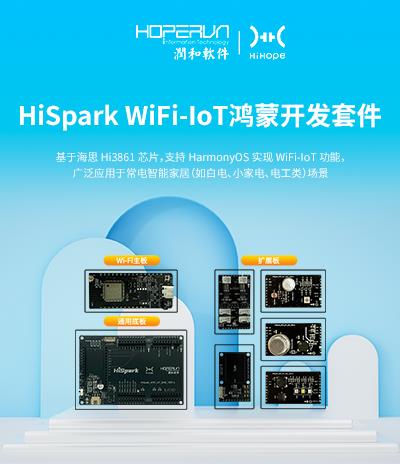WiFi-IoT 鸿蒙开发套件样例开发
Posted 润和HiHope社区
tags:
篇首语:本文由小常识网(cha138.com)小编为大家整理,主要介绍了WiFi-IoT 鸿蒙开发套件样例开发相关的知识,希望对你有一定的参考价值。
HiSpark WiFi-IoT鸿蒙开发套件 首发于HDC 2020,是首批支持HarmonyOS 2.0的开发套件,亦是鸿蒙官方推荐套件,由润和软件HiHope量身打造,已在鸿蒙社区和广大鸿蒙开发者中得到广泛应用。

一、Thread API osThreadNew() osThreadId_t osThreadNew(osThreadFunc_t func, void *argument,const osThreadAttr_t *attr ) 复制 注意 :不能在中断服务调用该函数 参数 osThreadTerminate() osStatus_t osThreadTerminate (osThreadId_t thread_id)复制 二、代码分析 创建线程,创建成功则打印线程名字和线程ID osThreadId_t newThread(char *name, osThreadFunc_t func, void *arg) osThreadAttr_t attr = name, 0, NULL, 0, NULL, 1024*2, osPriorityNormal, 0, 0 ; osThreadId_t tid = osThreadNew(func, arg, &attr); if (tid == NULL) printf("osThreadNew(%s) faiLED.\\r\\n", name); else printf("osThreadNew(%s) success, thread id: %d.\\r\\n", name, tid); return tid;复制 该函数首先会打印自己的参数,然后对全局变量count进行循环+1操作,之后会打印count的值 void threadTest(void *arg) static int count = 0; printf("%s\\r\\n",(char *)arg); osThreadId_t tid = osThreadGetId(); printf("threadTest osThreadGetId, thread id:%p\\r\\n", tid); while (1) count++; printf("threadTest, count: %d.\\r\\n", count); osDelay(20); 复制 主程序rtosv2_thread_main创建线程并运行,并使用上述API进行相关操作,最后终止所创建的线程。 void rtosv2_thread_main(void *arg) (void)arg; osThreadId_t tid=newThread("test_thread", threadTest, "This is a test thread."); const char *t_name = osThreadGetName(tid); printf("[Thread Test]osThreadGetName, thread name: %s.\\r\\n", t_name); osThreadState_t state = osThreadGetState(tid); printf("[Thread Test]osThreadGetState, state :%d.\\r\\n", state); osStatus_t status = osThreadSetPriority(tid, osPriorityNormal4); printf("[Thread Test]osThreadSetPriority, status: %d.\\r\\n", status); osPriority_t pri = osThreadGetPriority (tid); printf("[Thread Test]osThreadGetPriority, priority: %d.\\r\\n", pri); status = osThreadSuspend(tid); printf("[Thread Test]osThreadSuspend, status: %d.\\r\\n", status); status = osThreadResume(tid); printf("[Thread Test]osThreadResume, status: %d.\\r\\n", status); uint32_t stacksize = osThreadGetStackSize(tid); printf("[Thread Test]osThreadGetStackSize, stacksize: %d.\\r\\n", stacksize); uint32_t stackspace = osThreadGetStackSpace(tid); printf("[Thread Test]osThreadGetStackSpace, stackspace: %d.\\r\\n", stackspace); uint32_t t_count = osThreadGetCount(); printf("[Thread Test]osThreadGetCount, count: %d.\\r\\n", t_count); osDelay(100); status = osThreadTerminate(tid); printf("[Thread Test]osThreadTerminate, status: %d.\\r\\n", status); 三、如何编译 将此目录下的 thread.c 和 BUILD.gn 复制到openharmony源码的applications\\sample\\wifi-iot\\app\\iothardware目录下, 修改openharmony源码的applications\\sample\\wifi-iot\\app\\BUILD.gn文件,将其中的 features 改为: features = [ "iothardware:thread_demo", ]复制 3.在openharmony源码顶层目录执行:python build.py wifiiot 四、运行结果 [Thread Test] osThreadNew(test_thread) success.[Thread Test] osThreadGetName, thread name: test_thread.[Thread Test] osThreadGetState, state :1.[Thread Test] This is a test thread. <-testThread log[Thread Test] threadTest osThreadGetId, thread id:0xe8544[Thread Test] threadTest, count: 1. <-testThread log[Thread Test] osThreadSetPriority, status: 0.[Thread Test] osThreadGetPriority, priority: 28.[Thread Test] osThreadSuspend, status: 0.[Thread Test] osThreadResume, status: 0.[Thread Test] osThreadGetStackSize, stacksize: 2048.[Thread Test] osThreadGetStackSpace, stackspace: 1144.[Thread Test] osThreadGetCount, count: 12.[Thread Test] threadTest, count: 2. <-testThread log[Thread Test] threadTest, count: 3. <-testThread log[Thread Test] threadTest, count: 4. <-testThread log[Thread Test] threadTest, count: 5. <-testThread log[Thread Test] threadTest, count: 6. <-testThread log[Thread Test] osThreadTerminate, status: 0.复制 |
以上是关于WiFi-IoT 鸿蒙开发套件样例开发的主要内容,如果未能解决你的问题,请参考以下文章